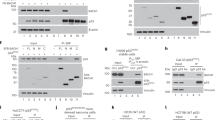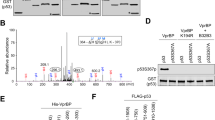Abstract
P53 is an important tumor suppressor that, upon activation, induces growth arrest and cell death. Control of p53 is thus of prime importance for proliferating cells, but also for cancer therapy, where p53 activity contributes to the eradication of tumors. Mdm2 functionally inhibits p53 and targets the tumor suppressor protein for degradation. In a genetic screen, we identified TRIM25 as a novel regulator of p53 and Mdm2. TRIM25 increased p53 and Mdm2 abundance by inhibiting their ubiquitination and degradation in 26 S proteasomes. TRIM25 co-precipitated with p53 and Mdm2 and interfered with the association of p300 and Mdm2, a critical step for p53 polyubiquitination. Despite the increase in p53 levels, p53 activity was inhibited in the presence of TRIM25. Downregulation of TRIM25 resulted in an increased acetylation of p53 and p53-dependent cell death in HCT116 cells. Upon genotoxic insults, TRIM25 dampened the p53-dependent DNA damage response. The downregulation of TRIM25 furthermore resulted in massive apoptosis during early embryogenesis of medaka, which was rescued by the concomitant downregulation of p53, demonstrating the functional relevance of the regulation of p53 by TRIM25 in an organismal context.
This is a preview of subscription content, access via your institution
Access options
Subscribe to this journal
Receive 50 print issues and online access
$259.00 per year
only $5.18 per issue
Buy this article
- Purchase on Springer Link
- Instant access to full article PDF
Prices may be subject to local taxes which are calculated during checkout







Similar content being viewed by others
References
Riley T, Sontag E, Chen P, Levine A . Transcriptional control of human p53-regulated genes. Nat Rev Mol Cell Biol 2008; 9: 402–412.
Boehme KA, Blattner C . Regulation of p53—insights into a complex process. Crit Rev Biochem Mol Biol 2009; 44: 367–392.
Nisole S, Stoye JP, Saib A . TRIM family proteins: retroviral restriction and antiviral defence. Nat Rev Microbiol 2005; 3: 799–808.
Inoue S, Orimo A, Hosoi T, Kondo S, Toyoshima H, Kondo T et al. Genomic binding-site cloning reveals an estrogen-responsive gene that encodes a RING finger protein. Proc Natl Acad Sci USA 1993; 90: 11117–11121.
Shimada N, Suzuki T, Inoue S, Kato K, Imatani A, Sekine H et al. Systemic distribution of estrogen-responsive finger protein (Efp) in human tissues. Mol Cell Endocrinol 2004; 218: 147–153.
Orimo A, Inoue S, Minowa O, Tominaga N, Tomioka Y, Sato M et al. Underdeveloped uterus and reduced estrogen responsiveness in mice with disruption of the estrogen-responsive finger protein gene, which is a direct target of estrogen receptor alpha. Proc Natl Acad Sci USA 1999; 96: 12027–12032.
Urano T, Saito T, Tsukui T, Fujita M, Hosoi T, Muramatsu M, Ouchi Y et al. Efp targets 14-3-3 sigma for proteolysis and promotes breast tumour growth. Nature 2002; 417: 871–875.
Zou W, Zhang DE . The interferon-inducible ubiquitin-protein isopeptide ligase (E3) EFP also functions as an ISG15 E3 ligase. J Biol Chem 2006; 281: 3989–3994.
Grossman SR, Perez M, Kung AL, Joseph M, Mansur C, Xiao ZX et al. p300/MDM2 complexes participate in MDM2-mediated p53 degradation. Mol Cell 1998; 2: 405–415.
Yuan J, Luo K, Zhang L, Cheville JC, Lou Z . USP10 regulates p53 localization and stability by deubiquitinating p53. Cell 2010; 140: 384–396.
Tang Y, Zhao W, Chen Y, Zhao Y, Gu W . Acetylation is indispensable for p53 activation. Cell 2008; 133: 612–626.
Sakaguchi K, Herrera JE, Saito S, Miki T, Bustin M, Vassilev A et al. DNA damage activates p53 through a phosphorylation-acetylation cascade. Genes Dev 1998; 12: 2831–2841.
Kobet E, Zeng X, Zhu Y, Keller D, Lu H . MDM2 inhibits p300-mediated p53 acetylation and activation by forming a ternary complex with the two proteins. Proc Natl Acad Sci USA 2000; 97: 12547–12552.
Balasubramanyam K, Varier RA, Altaf M, Swaminathan V, Siddappa NB, Ranga U et al. Curcumin, a novel p300/CREB-binding protein-specific inhibitor of acetyltransferase, represses the acetylation of histone/nonhistone proteins and histone acetyltransferase-dependent chromatin transcription. J Biol Chem 2004; 279: 51163–51171.
Amsterdam A, Nissen RM, Sun Z, Swindell EC, Farrington S . Hopkins. Identification of 315 genes essential for early zebrafish development. Proc Natl Acad Sci USA 2004; 101: 12792–12797.
Bartel F, Jung J, Böhnke A, Gradhand E, Zeug K, Thomssen C, Hauptmann S . Both germ line and somatic genetics of the p53 pathway affect ovarian cancer incidence and survival. Clin Cancer Res 2008; 14: 89–96.
Watanabe T, Imoto I, Kosugi Y, Ishiwata I, Inoue S, Takayama M et al. A novel amplification at 17q21-23 in ovarian cancer cell lines detected by comparative genomic hybridization. Gynecol Oncol 2001; 81: 172–177.
Souren M, Martinez-Morales JR, Makri P, Wittbrodt B, Wittbrodt J . A global survey identifies novel upstream components of the Ath5 neurogenic network. Genome Biol 2009; 10: R92.
Okumura N, Saji S, Eguchi H, Hayashi S, Nakashima S . Estradiol stabilizes p53 protein in breast cancer cell line, MCF-7. Jpn J Cancer Res 2002; 93: 867–873.
Kinyamu HK, Archer TK . Estrogen receptor-dependent proteasomal degradation of the glucocorticoid receptor is coupled to an increase in mdm2 protein expression. Mol Cell Biol 2003; 23: 5867–5881.
Hurd C, Dinda S, Khattree N, Moudgil VK . Estrogen-dependent and independent activation of the P1 promoter of the p53 gene in transiently transfected breast cancer cells. Oncogene 1999; 18: 1067–1072.
Brooks CL, Gu W . The impact of acetylation and deacetylation on the p53 pathway. Protein Cell 2011; 2: 456–462.
Nakayama H, Sano T, Motegi A, Oyama T, Nakajima T . Increasing 14-3-3 sigma expression with declining estrogen receptor alpha and estrogen-responsive finger protein expression defines malignant progression of endometrial carcinoma. Pathol Int 2005; 55: 707–715.
Lane DP . Cancer. p53, guardian of the genome. Nature 1992; 358: 15–16.
Ikeda K, Orimo A, Higashi Y, Muramatsu M, Inoue S . Efp as a primary estrogen-responsive gene in human breast cancer. FEBS Lett 2000; 472: 9–13.
Kulikov R, Letienne J, Kaur M, Grossman SR, Arts J, Blattner C . Mdm2 facilitates the association of p53 with the proteasome. Proc Natl Acad Sci USA 2010; 107: 10038–10043.
Solozobova V, Blattner C . Regulation of p53 in embryonic stem cells. Exp Cell Research 2010; 316: 2434–2446.
Loosli F, Koster RW, Carl M, Krone A, Wittbrodt J . Six3 a medaka homologue of the Drosophila homeobox gene sine oculis is expressed in the anterior embryonic shield and the developing eye. Mech Dev 1998; 74: 159–164.
Acknowledgements
We thank Germana Meroni (CBM S.c.r.l., Trieste) for the TRIM25 plasmid, Yi Su for help with the screening and Christina Bauer, Tanja Kuhn, Beate Heydel and Cathrin Herder for technical assistance. PZ was a CSC fellow. GD acknowledges the funding from the DFG (FOR 1036) for the screening experiments. This work is supported by COST Action BM1307.
Author information
Authors and Affiliations
Corresponding authors
Ethics declarations
Competing interests
The authors declare no conflict of interest.
Additional information
Supplementary Information accompanies this paper on the Oncogene website
Supplementary information
Rights and permissions
About this article
Cite this article
Zhang, P., Elabd, S., Hammer, S. et al. TRIM25 has a dual function in the p53/Mdm2 circuit. Oncogene 34, 5729–5738 (2015). https://doi.org/10.1038/onc.2015.21
Received:
Revised:
Accepted:
Published:
Issue Date:
DOI: https://doi.org/10.1038/onc.2015.21
This article is cited by
-
TRIM25 inhibition attenuates inflammation, senescence, and oxidative stress in microvascular endothelial cells induced by hyperglycemia
Graefe's Archive for Clinical and Experimental Ophthalmology (2024)
-
E3 ubiquitin ligases in cancer stem cells: key regulators of cancer hallmarks and novel therapeutic opportunities
Cellular Oncology (2023)
-
MALAT1-miRNAs network regulate thymidylate synthase and affect 5FU-based chemotherapy
Molecular Medicine (2022)
-
TRIM25 activates AKT/mTOR by inhibiting PTEN via K63-linked polyubiquitination in non-small cell lung cancer
Acta Pharmacologica Sinica (2022)
-
Inducible knockout of Clec16a in mice results in sensory neurodegeneration
Scientific Reports (2021)



